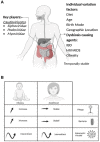The human gut virome: composition, colonization, interactions, and impacts on human health
- PMID: 37293229
- PMCID: PMC10244655
- DOI: 10.3389/fmicb.2023.963173
The human gut virome: composition, colonization, interactions, and impacts on human health
Abstract
The gut virome is an incredibly complex part of the gut ecosystem. Gut viruses play a role in many disease states, but it is unknown to what extent the gut virome impacts everyday human health. New experimental and bioinformatic approaches are required to address this knowledge gap. Gut virome colonization begins at birth and is considered unique and stable in adulthood. The stable virome is highly specific to each individual and is modulated by varying factors such as age, diet, disease state, and use of antibiotics. The gut virome primarily comprises bacteriophages, predominantly order Crassvirales, also referred to as crAss-like phages, in industrialized populations and other Caudoviricetes (formerly Caudovirales). The stability of the virome's regular constituents is disrupted by disease. Transferring the fecal microbiome, including its viruses, from a healthy individual can restore the functionality of the gut. It can alleviate symptoms of chronic illnesses such as colitis caused by Clostridiodes difficile. Investigation of the virome is a relatively novel field, with new genetic sequences being published at an increasing rate. A large percentage of unknown sequences, termed 'viral dark matter', is one of the significant challenges facing virologists and bioinformaticians. To address this challenge, strategies include mining publicly available viral datasets, untargeted metagenomic approaches, and utilizing cutting-edge bioinformatic tools to quantify and classify viral species. Here, we review the literature surrounding the gut virome, its establishment, its impact on human health, the methods used to investigate it, and the viral dark matter veiling our understanding of the gut virome.
Keywords: bacteriophage; fecal transplant; gut-brain axis; viral dark matter; virus.
Copyright © 2023 Pargin, Roach, Skye, Papudeshi, Inglis, Mallawaarachchi, Grigson, Harker, Edwards and Giles.
Conflict of interest statement
The authors declare that the research was conducted in the absence of any commercial or financial relationships that could be construed as a potential conflict of interest.
Figures

References
-
- Adiliaghdam F., Amatullah H., Digumarthi S., Saunders T. L., Rahman R.-U., Wong L. P., et al. . (2022). Human enteric viruses autonomously shape inflammatory bowel disease phenotype through divergent innate immunomodulation. Sci. Immunol. 7:eabn6660. doi: 10.1126/sciimmunol.abn6660, PMID: - DOI - PMC - PubMed
Publication types
LinkOut - more resources
Full Text Sources
Miscellaneous

